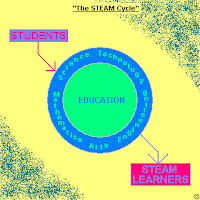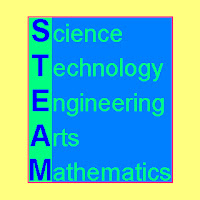Welcome 2013
Author: Manuel R. CortezRodas
"From MRCR Education to you.
May the new year bring the best in education for all who take part in it."
Copyright 2012. MRCR Educational Consulting Firm. All Rights Reserved.
 The STEAM education cycle begins when the student is introduced to the five strands of STEAM. Students who are educated in STEAM can become STEAM learners. This approach will challenge students to cross-reference what they are learning. It should allow students to connect and apply knowledge across the five unique strands in a way that expands their level of thinking. Understanding a scientific concept like the water cycle is not enough. The student should be able to relate the water cycle to tools in technology we have engineered like thermometers, barometers, and hydrometers which allow us to collect numeric data using a mathematical approach. This in turn will help us to better understand a scientific idea, while at the same time being able to visualize this cycle in a multitude of terrains as it takes place throughout the world.
The STEAM education cycle begins when the student is introduced to the five strands of STEAM. Students who are educated in STEAM can become STEAM learners. This approach will challenge students to cross-reference what they are learning. It should allow students to connect and apply knowledge across the five unique strands in a way that expands their level of thinking. Understanding a scientific concept like the water cycle is not enough. The student should be able to relate the water cycle to tools in technology we have engineered like thermometers, barometers, and hydrometers which allow us to collect numeric data using a mathematical approach. This in turn will help us to better understand a scientific idea, while at the same time being able to visualize this cycle in a multitude of terrains as it takes place throughout the world. STEAM education incorporates the following five strands: Science, Technology, Engineering, Arts, Mathematics. It is a collaborative effort, by all who are involved in education, to develop a curriculum that allows students to interconnect the elements of STEAM and apply them, not just to school and academics, but to their lives and future growth.
STEAM education incorporates the following five strands: Science, Technology, Engineering, Arts, Mathematics. It is a collaborative effort, by all who are involved in education, to develop a curriculum that allows students to interconnect the elements of STEAM and apply them, not just to school and academics, but to their lives and future growth. From one day to several years, the length of time an ELL student will require, to successfully exit the program, will be varied from student to student. It takes time for students to develop the skills needed to successfully communicate in a new language. Some students arrive with advanced English language skills from prior education, while others will be experiencing a new language for the first time. With a program for ELL students that has been established, and is successful, the transition from "English Learner" to "English Learned" will be proper, prompt, and perfect.
From one day to several years, the length of time an ELL student will require, to successfully exit the program, will be varied from student to student. It takes time for students to develop the skills needed to successfully communicate in a new language. Some students arrive with advanced English language skills from prior education, while others will be experiencing a new language for the first time. With a program for ELL students that has been established, and is successful, the transition from "English Learner" to "English Learned" will be proper, prompt, and perfect.